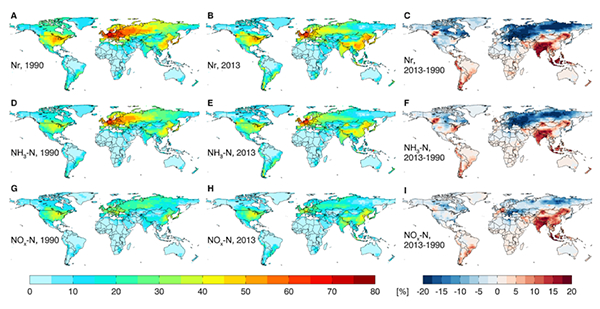With the support of the National Natural Science Foundation of China (grants 41822701, 42061124001, 41773068, 41922037, and 41721001), Dr. Baojing Gu (College of Environmental and Resource Sciences, Zhejiang University) and his colleagues made progress on global nitrogen pollution control. The research article was published in Science on November 5, 2021, entitled “Abating ammonia is more cost-effective than nitrogen oxides for mitigating PM2.5 air pollution”. (http://doi.org/10.1126/science.abf8623)
Nitrogen fertilizer use is crucial for global food production; However, over half of the nitrogen used in food production is discharged into the environment, leading to severe damages to human and ecosystem health. Managing nitrogen to balance food security and environmental protection is a grand challenge. This is particularly relevant to atmospheric emissions of nitrogen, which are important PM2.5 precursors. Previous quantifications of the health costs of nitrogen oxide (NOx) and ammonia (NH3) emissions from PM2.5 pollution have not been conducted on a global scale due to differences in atmospheric chemistry, population density and exposure characteristics relative to the pollution consequences of nitrogen emissions in different countries. Thus, a generic method is needed to ensure that the costs of mortality derived from nitrogen emissions are comparable across countries/regions and reflective of local conditions, which can be further used to inform the abatement of PM2.5 air pollution.
The research group used three atmospheric chemistry and transport models: EMEP-WRF, TM5-FASST and GEOS-Chem to estimate the contribution of nitrogen emission to the formation of PM2.5 (N-share). Results showed that approximately 40% of global PM2.5 pollution is due to nitrogen emission to the air, and surprisingly ammonia has a much larger N-share than that of nitrogen oxides. Nitrogen emissions to air caused an estimated 23.3 million life years lost in 2013, corresponding to an annual welfare loss of 420 billion United States dollars for premature death. The marginal abatement cost of ammonia emission is only 10% that of nitrogen oxides emission globally. Considering the overall costs and benefits, the analysis highlights the priority for air pollution policies to give increased attention to controlling NH3 emissions in order to complement successful policies on NOx and SO2 control. Since ammonia is mainly from agricultural sources, better management to cut NH3 emissions from fertilizer use and livestock production is needed.
This study developed new cost-effective ways for global PM2.5 pollution control, facilitating the policy-making on managing nitrogen use for both food security and environmental protection.

Fig. 1. N-shares of PM2.5 pollution and their changes between 1990 and 2013. Values represent the percentage contribution of each form of Nr emission to PM2.5 pollution, (a) Total Nr-share in 1990; (b) Total Nr-share in 2013; (c) Change in total Nr-share 2013–1990; (d) NH3-Nshare in 1990; (e) NH3-N share in 2013; (f) Change in NH3-N share 2013–1990; (g) NOx-Nshare in 1990; (h) NOx-N share in 2013; (i) Change in NOx-N share 2013–1990. Results are based on the average value of simulations from GEOS-Chem model and EMEP-WRF using 100% Nr emission reduction.

Add: 83 Shuangqing Rd., Haidian District, Beijing, China
Postcode: 100085
Tel: 86-10-62327001
Fax: 86-10-62327004
E-mail: bic@donnasnhdiary.org
京ICP备05002826号 文保网安备1101080035号 Copyright 2017 NSFC, All Right Reserved